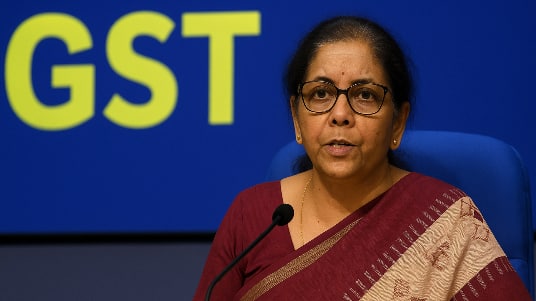For both large corporates and millions of small shopkeepers, the GST reforms promise higher footfalls, stronger festive sales, and a lasting shift in affordability for Indian households.

GST (Source: AI Image)
In a major relief for households ahead of Navratri and Diwali, Union Finance Minister Nirmala Sitharaman on Wednesday announced a wide-ranging rationalisation of GST rates on 396 items, calling it a “Navratri gift for the common man.”
Addressing the press after the 56th GST Council meeting, Sitharaman said the reforms were aimed at easing the tax burden on everyday essentials and boosting consumption across labour-intensive and key economic sectors.
“These reforms have been carried out with a focus on the common man. Every tax on the common man’s daily-use items has gone through a rigorous review and in most cases the rates have come down drastically,” the Finance Minister said.
“Labour-intensive industries have been given good support. Farmers, the agriculture sector, and the health sector will benefit. Key drivers of the economy will be given prominence,” the FM Said.
The announcements have created a positive repurcussions among industry leaders, some calling it a historic and consumer-friendly reform. The Central Government’s decision to rationalise GST rates across key categories of consumer goods, notably reducing tax on air-conditioners and televisions from 28% to 18% is expected to provide immediate relief to households and momentum to India’s retail economy.
Commenting on the same, Paresh Parekh, Partner and National Leader for Tax – Consumer Products & Retail, EY India said, “GST reforms and rate rationalisation across household essentials, FMCG goods and electronics are a timely and bold step by the Government. The tax cuts will directly lower consumer prices, offering relief to households, particularly in rural and semi-urban areas where FMCG demand is highly price-sensitive. Smaller packs may see added quantity instead of lower prices, still passing value to consumers."
He highlighted that the move is expected to revive consumption, especially during the festive season, unlocking growth in packaged food, personal care and staples. Administrative measures such as three-day GST registration for low-risk businesses and seven-day refunds for exporters will ease compliance and improve liquidity, particularly in the textile sector.
Garments and footwear up to INR 2,500 will now attract just 5% GST, boosting affordability. However, concerns remain on the 18% slab for higher-value apparel, which could impact middle-class buyers and handcrafted segments.
"FMCG distributors will need clarity on pricing, input tax credit and transition rules to avoid supply-chain disruption. Businesses must quickly map out where rate revisions apply, assess their input credits, and prepare for possible ‘incentives clawback’ linked to GST changes,” Parekh added.
Everyday essentials: GST on items such as hair oil, shampoo, toothpaste, soaps, toothbrushes, and shaving cream has been slashed from 18% to 5%, bringing down prices significantly.
Aspirational products: High-demand appliances like air conditioners, washing machines, televisions above 32 inches (LED/LCD), monitors, projectors, and dishwashers will now attract 18% GST instead of 28%.
The reforms are expected to provide immediate cheer to middle-class consumers, improve affordability, and create strong festive momentum for retailers and manufacturers alike.
Manish Sharma, Chairman of Panasonic Life Solutions India, welcomed the move, noting that lowering GST on high-demand appliances will make them more accessible.
“The rationalisation of GST on air-conditioners and televisions from 28% to 18% is a welcome reform that will directly benefit consumers, especially as we step into the festive season. With this reduction, products that were earlier seen as aspirational are now more accessible, allowing a larger section of households to upgrade to energy-efficient and connected appliances,” Sharma said.
He added that this tax cut, coupled with the recent revision in income tax slabs exempting annual earners up to INR 12 lakhs, is set to boost disposable incomes and consumer sentiment, accelerating demand in both urban and emerging markets. “At Panasonic, we believe this will accelerate penetration of modern appliances, improve quality of life for consumers, and in turn, contribute to India’s broader economic growth momentum,” he said.
The Confederation of All India Traders (CAIT) called the reforms “historic and revolutionary.” Sumit Agarwal, National Joint Secretary General of CAIT, said the rationalisation simplifies the tax structure and is expected to significantly boost consumption, creating fresh momentum for small traders and retailers.
A wide range of items across everyday categories will now become more affordable. From daily essentials including soap, detergent, toothpaste, and packaged food products, to appliances such as televisions, refrigerators, washing machines, and ACs, and even toys, bicycles, furniture, and kitchenware.
According to State Bank of India (SBI) estimates, the reforms are likely to drive a 7–8% surge in domestic consumption during the upcoming festive season.
E-commerce players are equally optimistic. Rajneesh Kumar, Chief Corporate Affairs Officer at Flipkart Group, said the reforms reflect the government’s vision of ease of living and ease of doing business.
“By lowering input costs for farmers, simplifying compliance for MSMEs, and enabling small sellers, artisans/weavers and smallholder farmers to seamlessly join e-commerce across states, these reforms will further strengthen India’s growth engine,” Kumar said.
He added that timely implementation ahead of the festive season will widen market access, fuel cross-category consumption, and accelerate India’s journey towards a “Viksit Bharat.”
The convergence of tax rationalisation, rising disposable incomes, and easing compliance norms creates a strong demand runway for consumer durables, FMCG, and retail trade. For both large corporates and millions of small shopkeepers, the GST reforms promise higher footfalls, stronger festive sales, and a lasting shift in affordability for Indian households.
As Sharma of Panasonic summed it up: “This reform is not just about lowering taxes—it’s about making technology and comfort more inclusive for India’s consumers.”
Empower your business. Get practical tips, market insights, and growth strategies delivered to your inbox
By continuing you agree to our Privacy Policy & Terms & Conditions
